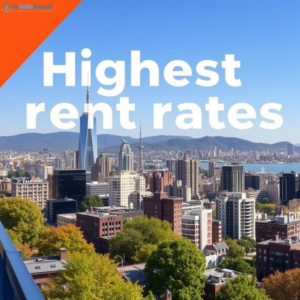The U.S. rental market continues to exhibit striking disparities in 2024, with certain states leading the nation in costs per square foot. These variations stem from factors such as housing availability, demand, and regional economic dynamics. An in-depth study by Perfect Rug, drawing on data from Zillow, World Population Review, and American Home Shield, reveals the top 10 states with the highest rental costs per square foot. Let’s explore the factors driving these costs and what it means for renters navigating these competitive markets.
10. Nevada
- Cost Per Square Foot: $104.30
- Average Home Size: 2,060 square feet
- Average Monthly Rent: $2,150
Nevada offers some of the most spacious homes on this list, which may attract renters looking for value in square footage. However, the high monthly rent reflects the increasing demand in cities like Las Vegas, driven by its booming economy and growing population.
9. Arizona
- Cost Per Square Foot: $107.10
- Average Home Size: 2,049 square feet
- Average Monthly Rent: $2,195
Arizona’s rental market remains competitive, especially in cities like Phoenix and Scottsdale, where a mix of urban appeal and warm weather draws new residents. The high rents reflect both the growing popularity of the state and a tightening housing supply.
8. Maine
- Cost Per Square Foot: $111.60
- Average Home Size: 1,680 square feet
With its picturesque coastal towns and small urban hubs, Maine has seen a surge in popularity as more Americans seek quieter, scenic lifestyles. However, the limited housing stock in such areas contributes to elevated rental costs per square foot.
7. Rhode Island
- Cost Per Square Foot: $112.30
Rhode Island may be small in size, but its rental market punches above its weight. The state’s proximity to major cities like Boston, combined with its attractive suburban and coastal settings, makes it a hotspot for renters willing to pay a premium.
6. New Jersey
- Cost Per Square Foot: $125.40
- Average Home Size: 1,753 square feet
New Jersey’s proximity to New York City has always kept its rental market competitive. While renters can find smaller homes compared to neighboring states, the per-square-foot costs remain steep due to the state’s high demand and urbanized areas like Jersey City and Hoboken.
5. Florida
- Cost Per Square Foot: $131.30
- Average Monthly Rent: $2,575
Florida has become a magnet for both retirees and remote workers seeking sunny weather and no state income tax. Cities like Miami, Orlando, and Tampa are experiencing housing shortages, which drives up rents. While larger homes are available, the per-square-foot cost reflects the state’s soaring popularity.
4. Massachusetts
- Cost Per Square Foot: $161.10
- Average Home Size: 2,300 square feet
Massachusetts strikes a balance between spacious homes and high-density housing markets. Boston, with its thriving job market and prestigious universities, anchors the state’s high rental costs. The state continues to attract renters despite its steep prices.
3. California
- Cost Per Square Foot: $161.20
- Average Home Size: 1,860 square feet
California has long been synonymous with a competitive housing market. From tech hubs in Silicon Valley to the entertainment capital of Los Angeles, high demand keeps rental costs elevated. Despite the smaller average home sizes, renters pay a premium for the state’s desirable lifestyle.
2. New York
- Cost Per Square Foot: $228.10
- Average Monthly Rent: $3,400
New York’s rental market is a reflection of its global prominence. With limited space and a relentless demand for housing in cities like New York City, prices remain among the highest in the country. Renters often trade space for proximity to the cultural and economic opportunities the state offers.
1. Hawaii
- Cost Per Square Foot: $244.80
- Average Home Size: 1,164 square feet
Topping the list, Hawaii presents a unique rental market characterized by breathtaking natural beauty and limited housing stock. Small home sizes and exceptionally high costs reflect the challenges of island living, where construction and land availability are inherently limited.
What This Means for Renters
The wide range of rental costs across the U.S. underscores the complexities of the housing market. While states like Nevada and Arizona offer larger homes, renters in New York and Hawaii must navigate steep costs for much smaller spaces. The trends suggest that factors such as job opportunities, lifestyle appeal, and housing availability heavily influence rental prices.
For renters, understanding these dynamics is essential. Those seeking affordability may need to prioritize states where housing supply aligns better with demand, while others might opt to pay a premium for lifestyle perks and proximity to urban centers.

